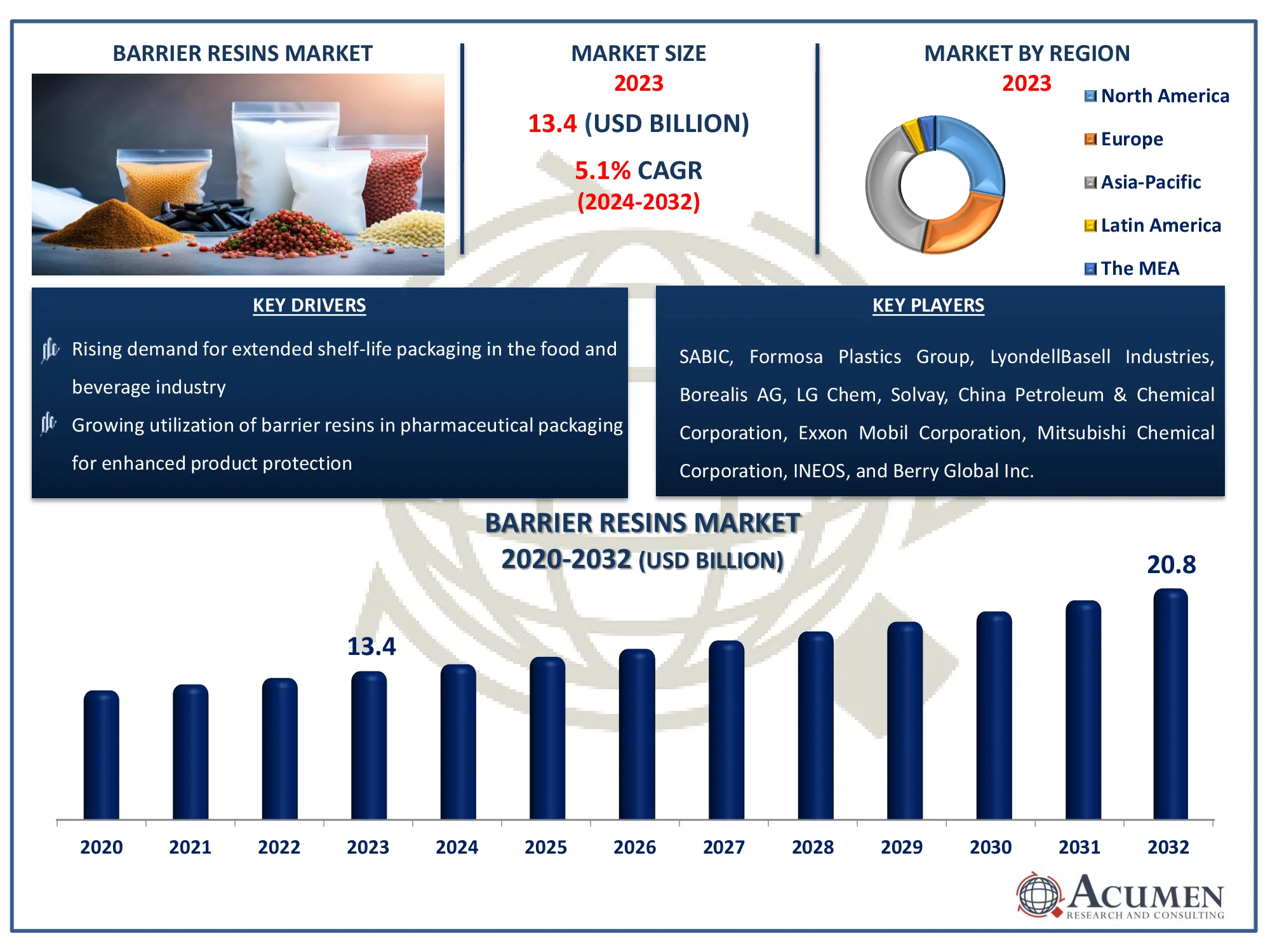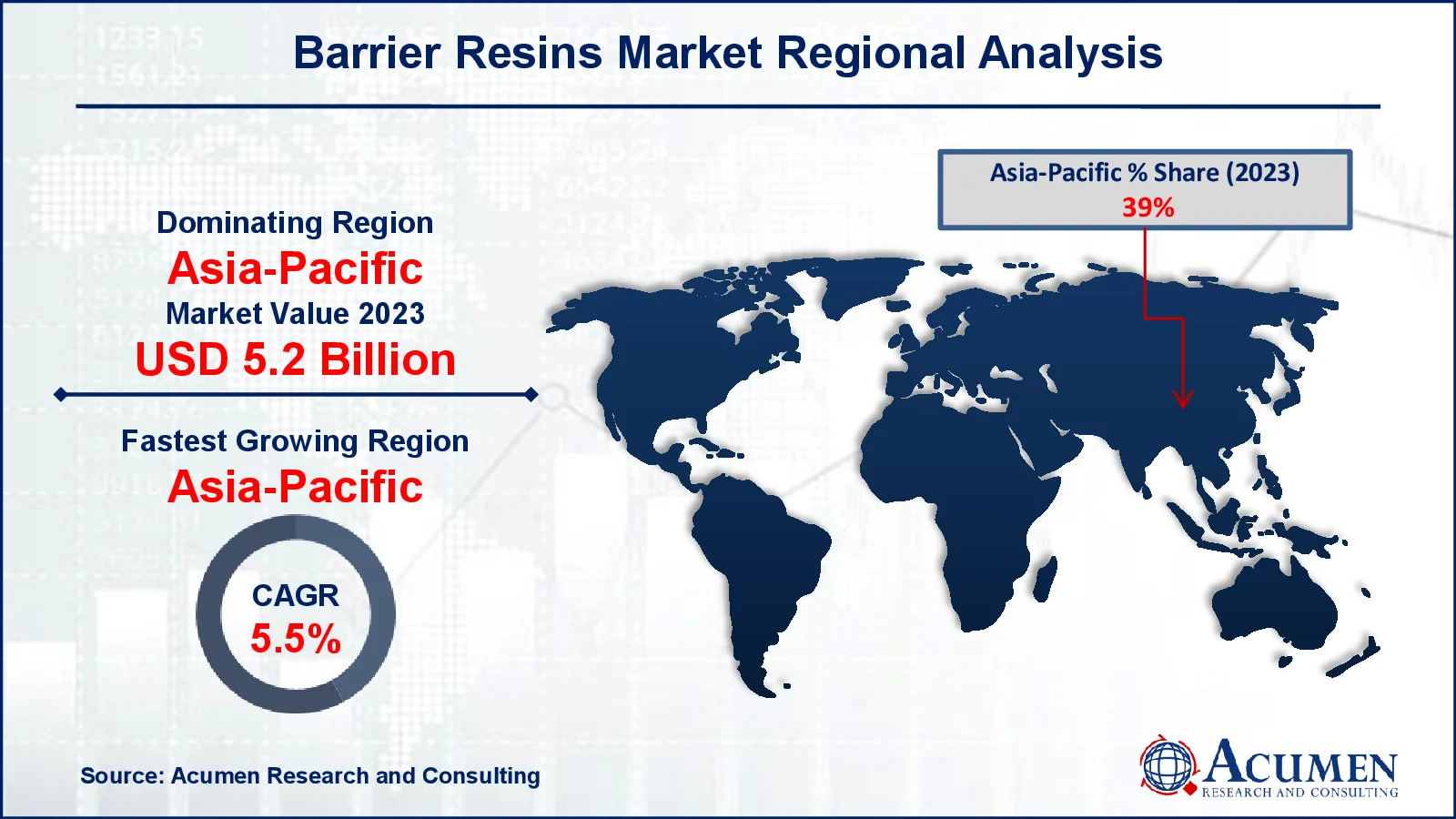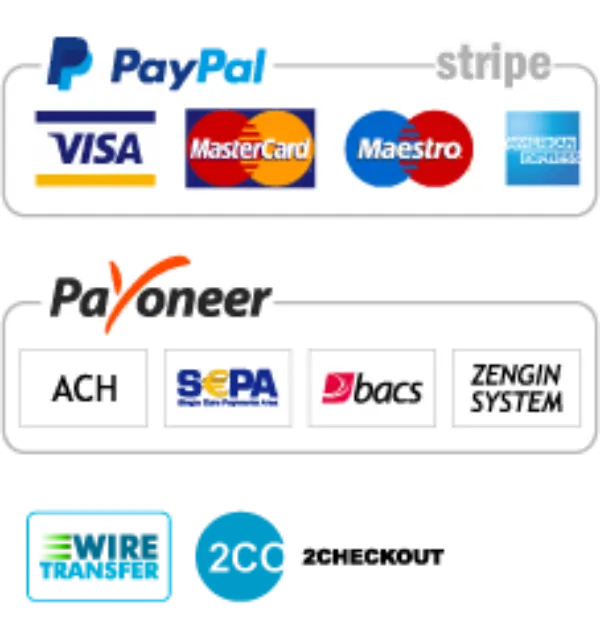Barrier Resins Market | Acumen Research and Consulting
Barrier Resins Market Size - Global Industry, Share, Analysis, Trends and Forecast 2024 - 2032
Published :
Report ID:
Pages :
Format :
The Global Barrier Resins Market Size accounted for USD 13.4 Billion in 2023 and is estimated to achieve a market size of USD 20.8 Billion by 2032 growing at a CAGR of 5.1% from 2024 to 2032.
Barrier Resins Market Highlights
- Global barrier resins market revenue is poised to garner USD 20.8 billion by 2032 with a CAGR of 5.1% from 2024 to 2032
- Asia-Pacific barrier resins market value occupied around USD 5.2 billion in 2023
- Asia-Pacific barrier resins market growth will record a CAGR of more than 5.5% from 2024 to 2032
- Among resin type, the ethylene vinyl alcohol sub-segment generated more than USD 3.8 billion revenue in 2023
- Based on end-use industry, the food & beverage sub-segment generated around 38% market share in 2023
- Collaboration between resin manufacturers and packaging companies for customized solutions is a popular barrier resins market trend that fuels the industry demand

Barrier resins are specially designed polymers that prevent gasses, moisture, and other contaminants from entering containers. These materials are widely employed in a number of industries, including as food and beverage, pharmaceuticals, cosmetics, and industrial applications. Superior barrier resins like ethylene vinyl alcohol (EVOH), polyvinylidene chloride (PVDC), and polyethylene terephthalate (PET) are commonly used. They help to extend the shelf life, keep freshness, and preserve the quality of packed commodities by acting as a barrier to oxygen, carbon dioxide, and water vapor. Barrier resins, which are available in both rigid and flexible packaging solutions, are gaining popularity due to their ability to promote sustainability and reduce food waste while ensuring product safety and quality.
Global Barrier Resins Market Dynamics
Market Drivers
- Rising demand for extended shelf-life packaging in the food and beverage industry
- Growing utilization of barrier resins in pharmaceutical packaging for enhanced product protection
- Increased adoption of sustainable and recyclable barrier resin materials
- Expanding use of barrier resins in industrial applications, including chemicals and lubricants
Market Restraints
High production costs associated with advanced barrier resin technologies
Limited recyclability of certain barrier resin materials, leading to environmental concerns
Fluctuating raw material prices impacting the profitability of manufacturers
Market Opportunities
- Innovation in bio-based barrier resins to meet sustainability goals
- Rising e-commerce trends driving demand for durable and protective packaging solutions
- Expansion in emerging markets with growing packaging requirements across industries
Barrier Resins Market Report Coverage
|
Market |
Barrier Resins Market |
|
Barrier Resins Market Size 2023 |
USD 13.4 Billion |
|
Barrier Resins Market Forecast 2032 |
USD 20.8 Billion |
|
Barrier Resins Market CAGR During 2024 - 2032 |
5.1% |
|
Barrier Resins Market Analysis Period |
2020 - 2032 |
|
Barrier Resins Market Base Year |
2023 |
|
Barrier Resins Market Forecast Data |
2024 - 2032 |
|
Segments Covered |
By Packaging Type, By Resin Type, By End-Use Industry, and By Geography |
|
Regional Scope |
North America, Europe, Asia Pacific, Latin America, and Middle East & Africa |
|
Key Companies Profiled |
SABIC, Formosa Plastics Group, LyondellBasell Industries, Borealis AG, LG Chem, Solvay, China Petroleum & Chemical Corporation, Exxon Mobil Corporation, Mitsubishi Chemical Corporation, INEOS, and Berry Global Inc. |
|
Report Coverage |
Market Trends, Drivers, Restraints, Competitive Analysis, Player Profiling, Covid-19 Analysis, Regulation Analysis |
Barrier Resins Market Insights
The global food and beverage industry relies heavily on barrier resins to extend the shelf life of packaged goods. These resins inhibit the passage of oxygen and moisture, two important drivers of food breakdown. As customer demand for ready-to-eat, processed, and perishable foods grows, barrier packaging materials become increasingly critical. Manufacturers are increasingly employing advanced barrier resins like polyethylene and polyvinylidene chloride (PVDC) to reduce food waste while maintaining product quality. Furthermore, the expansion of e-commerce food delivery services raises the demand for packaging solutions that keep products fresh, boosting demand for barrier resins in this industry.
The rising emphasis on sustainability has offered prospects for the development of bio-based barrier materials. These eco-friendly alternatives are derived from renewable resources and offer comparable protection to traditional resins while having a smaller environmental impact. Industries are investing in R&D to develop biodegradable and compostable barrier resins to meet customer demand for environmentally friendly packaging choices. Government laws that promote sustainable activities and reduce plastic waste stimulate the usage of these novel materials. The rise of environmentally conscious consumers, particularly in developed countries, provides huge potential opportunities for bio-based barrier resins in a wide range of applications, including food, beverages, and pharmaceuticals.
Barrier Resins Market Segmentation
The worldwide market for barrier resins is split based on packaging type, resin type, end-use industry, and geography.
Barrier Resins Market By Packaging Type
- Rigid Packaging
- Flexible Packaging
According to barrier resins industry analysis, the flexible packaging category is expected to be significant in the market because to its adaptability, lightweight design, and improved performance in preserving product integrity. Its capacity to conform to varied shapes while providing great protection against oxygen, moisture, and UV radiation has made it a popular choice in industries such as food & beverage, medicine, and personal hygiene. The increased need for convenience foods, single-use portions, and environmentally friendly packaging solutions is driving the adoption of flexible packaging. Furthermore, developments in materials, such as multi-layered films and bio-based barrier resins, improve functioning while complying with environmental requirements. As e-commerce grows globally, flexible packaging's cost-effectiveness and durability consolidate its position as the leading category in the barrier resins industry.
Barrier Resins Market By Resin Type
- Ethylene Vinyl Alcohol
- Polyvinylidene Chloride
- Polyethylene Naphthalate
- Polyethylene Terephthalate
- Polyamide
- Polyethylene
- Polyvinyl Alcohol
- Polypropylene
- Others (PS, PVC, EVA& Bio-Based)
Ethylene vinyl alcohol (EVOH) is anticipated to be the fastest-growing type in the market of barrier resins. EVOH is a flexible thermoplastic barrier resin and has major applications in pharmaceutical and food & beverage packaging. It is transparent, moldable, recyclable and oil & solvent resistant. Under humid conditions, the EVOH barrier resin has greater barrier properties in comparison to other high barrier resources. The EVOH barrier resin offers flavor preservation in coffee, oxygen barrier in medical packaging and barrier to solvents and fragrance in cosmetics packaging.
Barrier Resins Market By End-Use Industry
- Pharmaceutical & Medical
- Food & Beverage
- Cosmetics
- Industrial
- Agriculture
- Others
The food & beverages industry is one of the key applications areas of barrier resins, where the resin is mainly used in the packaging of foodstuffs such as canned milk, fish, meat, wine, beer, canned fruits and vegetables and carbonated soft drinks. Use of barrier resins offer long lasting flavor, extended shelf life and maintains the quality of food by preventing odor and oxygen from penetrating the package and protects sensitive vitamin content. In the packaging of meat, barrier resins work as a protection against the permeation of moisture, oxygen and UV rays. It also protects the aroma and flavor in the product.
Barrier Resins Market Regional Outlook
North America
- U.S.
- Canada
Europe
- U.K.
- Germany
- France
- Spain
- Rest of Europe
Asia-Pacific
- India
- Japan
- China
- Australia
- South Korea
- Rest of Asia-Pacific
Latin America
- Brazil
- Mexico
- Rest of LATAM
The Middle East & Africa
- South Africa
- GCC Countries
- Rest of the Middle East & Africa (ME&A)

Barrier Resins Market Regional Analysis
The barrier resins market varies significantly by area, owing to variances in industrial activity, customer preferences, and regulatory framework. The Asia-Pacific area is predicted to largest and expands the fastest due to rapid industrialization, urbanization, and a thriving food and beverage industry. This demand is being driven by emerging nations like China and India, where consumers increasingly prefer packaged and processed meals. Furthermore, the region's growing e-commerce and pharmaceutical industries are increasing demand for barrier resins.
North America holds the notable industry share during the barrier resins market forecast period, owing to the substantial presence of the food and beverage industry and growing need for sustainable packaging solutions. The region also benefits from technical advancements and the rapid adoption of innovative materials in medical and industrial settings.
Europe follows closely, owing to strong environmental rules and the growing use of recyclable and bio-based barrier resins. Countries such as Germany, France, and the United Kingdom are important contributors, with strong packaging industries and an emphasis on decreasing plastic waste. The region's emphasis on environmentally friendly materials is accelerating the use of innovative barrier resins.
Barrier Resins Market Players
Some of the top barrier resins companies offered in our report include SABIC, Formosa Plastics Group, LyondellBasell Industries, Borealis AG, LG Chem, Solvay, China Petroleum & Chemical Corporation, Exxon Mobil Corporation, Mitsubishi Chemical Corporation, INEOS, and Berry Global Inc.
Frequently Asked Questions
How big is the barrier resins market?
The barrier resins market size was valued at USD 13.4 Billion in 2023.
What is the CAGR of the global barrier resins market from 2024 to 2032?
The CAGR of barrier resins is 5.1% during the analysis period of 2024 to 2032.
Who are the key players in the Barrier Resins market?
The key players operating in the global market are including SABIC, Formosa Plastics Group, LyondellBasell Industries, Borealis AG, LG Chem, Solvay, China Petroleum & Chemical Corporation, Exxon Mobil Corporation, Mitsubishi Chemical Corporation, INEOS, and Berry Global Inc.
Which region dominated the global barrier resins market share?
Asia-Pacific held the dominating position in barrier resins industry during the analysis period of 2024 to 2032.
Which region registered fastest CAGR from 2024 to 2032?
Asia-Pacific region exhibited fastest growing CAGR for market of barrier resins during the analysis period of 2024 to 2032.
What are the current trends and dynamics in the global barrier resins industry?
The current trends and dynamics in the barrier resins industry include rising demand for extended shelf-life packaging in the food and beverage industry, and growing utilization of barrier resins in pharmaceutical packaging for enhanced product protection.
Which resin type held the maximum share in 2023?
The ethylene vinyl alcohol resin type held the maximum share of the barrier resins industry.



